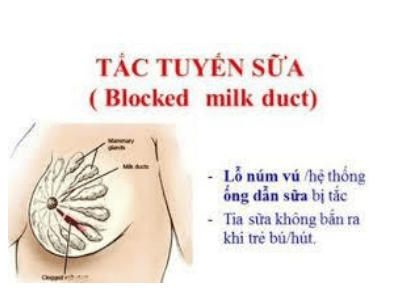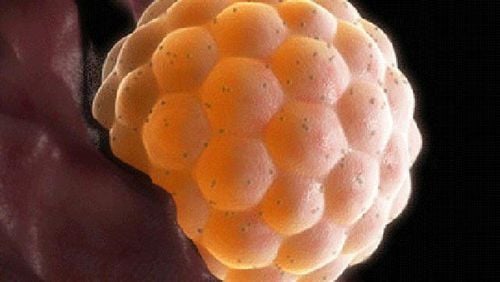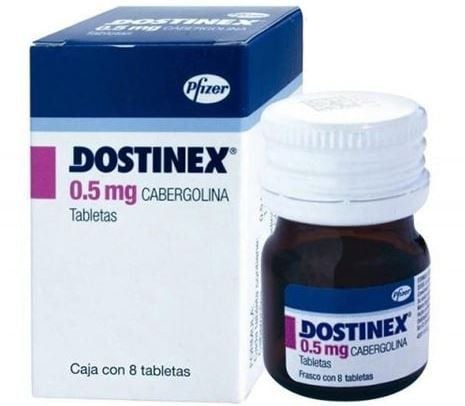This is an automatically translated article.
The article was professionally consulted by Specialist Doctor II Lai Thi Nguyet Hang - Department of Obstetrics and Gynecology - Vinmec Ha Long International General Hospital.Blocked milk ducts, also known as blocked milk ducts, are quite common in nursing mothers, especially in the early stages after the baby is born. Blocked milk ducts seem simple but cause quite a lot of trouble if not handled properly and timely. Mothers should take measures to prevent blocked milk ducts from the time they start breastfeeding
1. Why is the duct blocked?
A blocked milk duct is a blocked milk duct that results in poor or insufficient milk flow. When milk accumulates behind the blockage, pressure builds up in the ducts which can lead to local discomfort in the breast, or possibly the formation of a lump.It is not always possible to find a specific reason why the milk ducts are blocked, however, the lack of milk circulation can be considered as one of the factors causing this condition. Blocked ducts can also lead to mastitis if left untreated for a long time.

2. Signs of blocked milk ducts
Signs of blocked milk ducts can come on gradually. A blocked milk duct can appear as a soft lump the size of a pea or larger and sometimes presents as a small white blister on the nipple. The breast may be sensitive and a tender mass may be palpable or there may be no palpable margin of this mass, no redness or fever (<38.4°C). Babies may be fussy when sucking from a blocked breast because the rate at which milk flows from the breast may be reduced. The general health of the mother is not affected in the case of blocked milk ducts.3. When does inflammation become more dangerous?
It will be a mistake if you do nothing to correct blocked milk ducts. The blockage won't be able to fix itself if you don't try to fix it. Instead, it can progress to an infection known as mastitis. Note that fever is not a symptom you will experience with blocked milk ducts. If you have pain and other symptoms along with a fever, you may have an infection.Symptoms of mastitis can come on suddenly and include:
Fever of 38.3°C or higher Appearance of flu-like symptoms (chills and body aches) Heat, swelling and pain all over breast lumps or thickening of breast tissue Burning and/or discomfort while breastfeeding or pumping Redness on the affected skin (may be wedge-shaped) If you have had mastitis in the past, you are more likely to get it again. Mastitis if left untreated can lead to a breast abscess that requires surgical drainage. If you have blocked milk ducts, you need to consult a lactation consultant or healthcare professional first. If your breasts are red, you may also have engorgement. If your symptoms are accompanied by a fever or feeling unwell, you may have mastitis.

4. Treatment of blocked milk ducts
At the first sign of blocked milk ducts, you should address the problem quickly. One of the most effective treatments is breast massage, especially when you are breastfeeding or pumping. To massage, start from the outside of the breast and apply pressure with your fingers as you move towards the nipple. You can also massage while you are in the shower.You can also use other tips to unclog:
Continue breastfeeding Start breastfeeding on the affected breast to make sure that breast gets the most milk from your baby. Newborns tend to suck most strongly on the first breast they are given (because they are hungrier). Consider soaking your breasts in a bowl of warm water and then massaging the blockage. Try varying positions you breastfeed. Sometimes moving around allows sucking force from the baby's mouth to act differently on the blockage sites, helping to better resolve the blockage. If you have mastitis, you should see your doctor to get it checked, most likely you will be treated with antibiotics. The drug can be taken for a period of 10 days. Be sure to take all of your medications as directed to prevent a recurrence of mastitis.
Over-the-counter pain relievers can also help relieve discomfort from mastitis. Your doctor may suggest that you take Tylenol (acetaminophen) or Advil/Motrin (ibuprofen).

5. When to see a doctor
If redness or bruising on your breasts persists for a week or so after you've cleared or treated mastitis, you should see your doctor.However, if you are concerned or feel a blockage or infection is not healing, make an appointment with your doctor immediately. In some cases, you may need another course of antibiotics or additional treatments, like draining an abscess.
If symptoms persist, your doctor may recommend a mammogram, ultrasound, or biopsy to rule out inflammatory breast cancer. This rare form of cancer can sometimes cause symptoms similar to mastitis, such as swelling and redness.
6. Prevent blocked milk ducts
You can get advice from lactation experts on how to prevent blocked milk ducts. The key to resolving blocked ducts is to clear the milk at the site of the blockage, and prevention should focus on avoiding factors that can lead to blocked ductsAvoid wearing tight clothing, such as bras underwire Get as much rest as possible Applying heat to your breasts with a hot pack before breastfeeding helps to stimulate milk flow and cooling with a cool pack after breastfeeding helps reduce pain and inflammation. After 9 months and 10 days of heavy weight, pregnant women entered labor and faced a level of labor pain comparable to 20 broken ribs at the same time. In order for the birth to go smoothly and safely, pregnant women need to understand: - How the labor process takes place, how long does it usually take to have a normal delivery or cesarean section, to protect the best health? for the unborn baby.
Methods to relieve pain during childbirth, limit pain and relieve psychological pressure during labor. The way to push and breathe during childbirth is usually the right way so that the labor takes place quickly, the pregnant woman does not lose strength during childbirth. How to control postpartum uterine contractions in the shortest time. How to take care of the perineal suture does not cause infection and dangerous complications. Early postpartum re-examination to detect dangerous abnormalities such as residual placenta, missing gauze. Take care of the newborn until full month healthy. To ease the pain of childbirth, Vinmec offers a full Maternity program with a complete "painless delivery" service during and after birth using non-morphine epidural and sedation techniques. ashamed. During the birth process, the mother will be guided by the midwives on how to push and breathe properly, the baby will be born in just 10-15 minutes. After birth, the baby will be cared for in a sterile room before being returned to the mother.
Pregnant women will rest in a high-class hospital room, designed according to international hotel standards, 1 mother 1 room with full facilities and modern equipment. Mothers will be consulted by nutritionists on how to feed the baby before being discharged from the hospital. Postpartum follow-up with both mother and baby with leading Obstetricians and Paediatricians.
Please dial HOTLINE for more information or register for an appointment HERE. Download MyVinmec app to make appointments faster and to manage your bookings easily.
Reference source: healthline.comSEE MORE
Proper massage helps to effectively cure blocked milk ducts How to relieve sore nipples when breastfeeding Treat blocked milk ducts with physical methods














